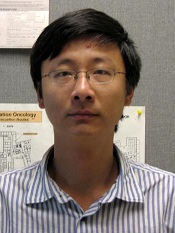Program Information
Radiomics for Lung Cancer
F Yin1*, R Li2*, D Mackin3*, (1) Duke University Medical Center, Durham, NC, (2) Stanford University, Palo Alto, CA, (3) MD Anderson Cancer Center, Houston, TX
Presentations
4:30 PM : Correlating of radiomics and dosiomics information with clinical outcomes for lung SBRT - F Yin, Presenting Author5:00 PM : Imaging and molecular biomarkers of lung cancer prognosis - R Li, Presenting Author
5:30 PM : Uncertainty, robustness, and harmonization in radiomics studies of lung cancer - D Mackin, Presenting Author
TU-H-205-0 (Tuesday, August 1, 2017) 4:30 PM - 6:00 PM Room: 205
Imaging plays an important role in cancer diagnosis, staging, and treatment response evaluation. Recent studies suggest that imaging could also serve as potentially useful prognostic and predictive biomarkers for personalized medicine. There has been significant interest in extracting quantitative information from clinical standard-of-care images, i.e., radiomics, to better predict prognosis and therapy response than simple measurements such as tumor size or volume. These imaging-derived phenotypes can be linked with aspects of tumor biology (such as genomics) and treatment characteristics (such as radiation dosimics) for improved clinical decision making in clinical oncology.
This symposium will discuss some of the recent advances in the field and their clinical applications, with a focus on lung cancer. Specifically, we will introduce methodology to extract large amount data related to radiomics and dosiomics, and correlate with clinical outcomes to identify potential biomarkers for treatment assessment and prediction for lung SBRT. We will investigate image features that go beyond those describing the gross tumor, evaluate their prognostic value in lung cancer, and identify the underlying molecular biology associated with these imaging phenotypes. Last but not least, we will examine the important issue of repeatability and robustness of the radiomics features, and discuss some image preprocessing methods that can harmonize images produced using inconsistent protocols.
Learning Objectives:
1. Learn about recent methods to combine radiomics and dosiomics for response evaluation in lung cancer therapy.
2. Learn about recent methods to combine radiomics and genomics for predicting lung cancer prognosis.
3. Understand the sources of variations of radiomic features and learn about methods to mitigate these technical issues.
Handouts
- 127-35282-418554-127153.pdf (F Yin)
- 127-35283-418554-126568.pdf (R Li)
- 127-35284-418554-127426.pdf (D Mackin)
Contact Email:





